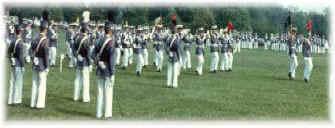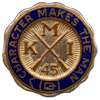They
weren’t exactly the Calvary, but it must have felt like it when the
first trainload of cadets, instructors and staff of the Kentucky
Military Institute rolled into the Venice Depot on Jan. 5, 1933.
An estimated 1,500 Suncoast residents, some from as far away as
Sarasota and Fort Myers, converged on the depot about 5 p.m. to welcome
the school and the financial support it promised the beleaguered city.
With an enrollment of some 250 students, it was said at the time that
when the school arrived for its winter session, KMI doubled the
population of Venice.
Formed in 1845 in Frankfort, Kentucky, and one of the first to be
affiliated with the U.S. Army’s Reserve Officer Training Corps, KMI was
one of the oldest military schools of its kind in the nation.
More than 11,000 boys matriculated at the military preparatory school
during its 126-year history, and went on to distinguish themselves in
all walks of life. Alumni bravely served in all wars up to and
including Vietnam, and seven generals during the Civil War were KMI
graduates, five for the Union and two for the Confederacy.
DISTINGUISHED ALUMNI
Other distinguished alumni include: actors Victor Mature and Jim
Backus, television comedian Fred Willard, and Indianapolis race car
driver Danny Sullivan. Although military service was not required as a
result of attending KMI, many alumni did choose to ultimately serve the
nation in uniform.
The school was founded by Col. Robert T. Allen, a West Point graduate
and distinguished Army officer who also was an inventor and former
college professor. Col. Charles Fowler, an 1878 graduate of KMI,
purchased the school in 1894 and moved it two years later to a former
plantation in Lyndon, Kentucky, a suburb of Louisville.
Believing that outdoor recreation would benefit the cadets in their
scholastic work, Fowler established a winter campus for the school in
1906 in Eau Gallie, Florida, located near Melbourne. The annual trip
for the winter session continued until January 1920 when a number of
buildings on the Florida campus were destroyed by fire. Because of
that, and a separate fire on the Kentucky campus, the school was forced
into bankruptcy.
Four instructors from the Greenbriar Military School, led by Col.
Charles B. Richmond, purchased and reopened KMI in 1924 with an
enrollment of 150 cadets. Like Fowler, Richmond also believed in the
positive effects of the Florida climate and began searching for a
winter campus.
Several
potential sites were considered, but Venice eventually was chosen.
According to an article in the June 1, 1932 edition of the Sarasota
Herald-Tribune, the selection of Venice was influenced by Ray
Richardson, a 1906 graduate of KMI who served as the school’s
commandant in 1909 and 1910.
CLASSROOMS AND HOUSING
KMI leased the former San Marco Hotel and Hotel Venice from the
Brotherhood of Locomotive Engineers in July 1932. The first floor of
the San Marco would be used for classrooms and office space while
cadets and some school staff would be housed on the second and third
floors.
Students and faculty also were housed in the Hotel Venice building, and
all meals were served in that building’s dining room. Both buildings
were leased until 1939 when the school purchased them along with the
former Orange Blossom Garage next door that presently houses the Venice
Theatre.
That building was used as KMI’s gymnasium and armory where military
science classes also were
The
entire school would come down to the winter campus after the Christmas
holiday on a special train nicknamed the KMI Special. Annual tuition in
1933 was $950, which included travel to Florida and meals.
The Depression did not directly affect the school and having a winter
campus was also a marketing strategy that boosted the school’s
enrollment. KMI would remain on the winter campus until just before
Easter and would then return to its Lyndon campus for the remainder of
the academic year.
Through its ROTC affiliation, regular Army personnel were assigned to
KMI and taught military science courses while also overseeing drills,
dress parades and other exercises. What is now Centennial Park
originally served as the school’s parade grounds and formal dress
parades were held there on alternate Sunday afternoons for the public’s
benefit.
Thousands would come from as far away as Tampa and Fort Myers to enjoy
the spectacle.
Although the drill field had not been completed when the first cadets
arrived in 1933, the first formal dress parade was held on Jan. 14th in
front of the San Marco, and the 25-piece cadet band provided the music.
In addition to leasing the two former hotels, KMI also was entitled to
use the city’s bath house which contained showers and dressing rooms.
The school also was provided use of the local nine-hole golf course and
clubhouse.
Each day’s activities were regulated by recorded bugle calls. Students
awoke at 6:30 a.m. to the sound of Reveille, and retired each evening
at 10 p.m. to Taps.
Drill exercises were held three times each week and all cadets
participated in athletic events each afternoon at 3:30 p.m. following
classes. The entire corps marched to every meal and, during inclement
weather, formations were held in the grand hallway of the San Marco.
Cadets were required each week to clean the rifles assigned to them.
The rifles were subject to periodic inspection.
HONOR CODE
In typical military fashion, KMI operated on a merit-based system.
Infractions of the rules received demerits and days free of “sticks”
earned merits. A merit would cancel out two demerits, and if a cadet
ended up with more demerits than merits, that cadet would have to “walk
the beat,” which meant marching with his rifle along a sandy, square
path behind the San Marco. Suffice to say, that path experienced a good
deal of foot traffic.
KMI’s motto was “Character Makes the Man,” which reflected the school’s
honor code. Cadets signed an oath for each test they took that stated
they had neither given nor received help on the exam. Those who
committed major infractions such as drinking, stealing or cheating
could be expected to find themselves on the next bus home.
The
families of cadets who visited during the winter session would stay at
local hotels such as the Venezia, the El Patio, and the Park View Hotel
which was located on the present site of the Post Office. In the early
days, families could also rent some of the homes abandoned during the
Depression.
KMI’s last season in Venice was in 1970. The school formally closed the
following year, a victim of the growing resentment against the military
and the nation’s involvement in the Vietnam War.
Although a half century has passed since KMI called Venice home, its
presence can still be felt. The Florida Legislature approved the
renaming of the KMI Bridge onto the island in 2014. Sarasota County
dedicated a marker in Centennial Park that tells the history of the
school in Venice. And a new exhibit about the school, funded by the KMI
Alumni Association, was formally opened in the grand hallway of the San
Marco building. The exhibit is open to the public and can be viewed
Monday through Saturday during business hours.
Larry Humes is a 1965 graduate of KMI and writes about local history.
He can be reached at 1926venice@gmail.com.

